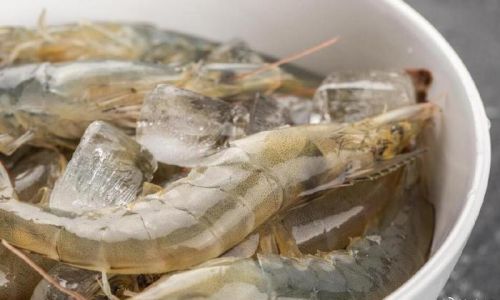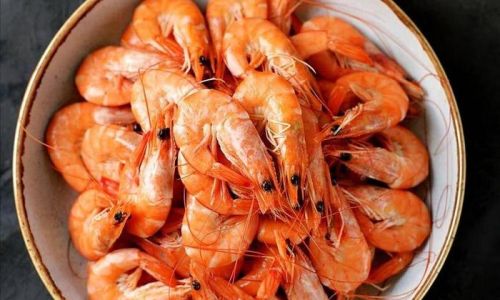Introduction: Understanding the Preservation Needs of Fresh Shrimp
In the realm of seafood, fresh shrimp stands out as a versatile and highly sought-after ingredient. Its delicate flavor, tender texture, and nutritional benefits make it a staple in countless cuisines worldwide. However, the challenge lies in maintaining its freshness, especially for those who enjoy shrimp but don’t consume it immediately after purchase. This brings us to a crucial question: can fresh shrimp be stored in the refrigerator for preservation?

To answer this question comprehensively, we must delve into several aspects, including the biology of shrimp, the impact of temperature on its shelf life, proper storage techniques, and potential risks associated with improper handling. By understanding these factors, consumers can ensure that their shrimp remains as fresh and delicious as possible, even after being stored for a period.
The Biology of Shrimp and Its Sensitivity to Temperature
Shrimp are cold-blooded creatures, meaning their body temperature fluctuates with their surroundings. This sensitivity to temperature plays a crucial role in their preservation. Fresh shrimp, particularly those caught or harvested recently, contain high moisture levels and are prone to rapid spoilage if not handled properly.
Bacteria and enzymes present in shrimp tissue can quickly break down proteins and fats, leading to off-flavors, discoloration, and texture changes. These changes are accelerated at warmer temperatures, making it imperative to store shrimp in a cool environment to slow down the spoilage process.
The Role of Refrigeration in Preserving Fresh Shrimp
Refrigeration is a fundamental practice in food preservation, leveraging the principle that lower temperatures slow down biochemical reactions. By storing shrimp in a refrigerator, consumers can significantly extend its shelf life while maintaining its quality.
Ideal Refrigeration Temperatures:
For optimal preservation, fresh shrimp should be stored at temperatures between 32°F and 39.2°F (0°C and 4°C). This range is commonly maintained in household refrigerators, making them a suitable choice for short-term storage.
Impact on Shelf Life:
When stored properly, fresh shrimp can typically last for one to two days in the refrigerator. This timeframe allows consumers to plan their meals without rushing to consume the shrimp immediately after purchase. However, it’s crucial to note that even under refrigeration, shrimp will gradually lose quality over time. Therefore, it’s best to use shrimp as soon as possible to enjoy its peak freshness.
Proper Storage Techniques for Fresh Shrimp
To maximize the preservation benefits of refrigeration, consumers must adhere to specific storage techniques. These practices ensure that shrimp remains fresh, safe to eat, and retains its optimal texture and flavor.

Prompt Refrigeration:
The moment shrimp is purchased, it should be placed in the refrigerator as soon as possible. Avoid leaving it out at room temperature for extended periods, as this accelerates spoilage. If you’re buying shrimp from a market or fishmonger, consider using a cooler with ice packs to transport it home.
Proper Packaging:
When storing shrimp in the refrigerator, use airtight containers or resealable plastic bags to prevent the ingress of oxygen and contaminants. Oxygen can promote the growth of bacteria, leading to faster spoilage. Additionally, label the packaging with the date of purchase to keep track of how long the shrimp has been stored.
Avoid Cross-Contamination:
To prevent cross-contamination, store shrimp separately from other foods, particularly those that may have strong odors or juices. This helps maintain the delicate flavor and aroma of the shrimp.
Rinse Before Use:
Before cooking, rinse shrimp under cold running water to remove any surface contaminants or ice glaze. Pat it dry with paper towels to prevent excess moisture from affecting the cooking process.
The Limitations of Refrigeration and the Role of Freezing
While refrigeration is effective for short-term preservation, it has limitations. For longer-term storage, freezing is a more viable option. Freezing shrimp at temperatures below 0°F (-18°C) effectively halts biochemical reactions, significantly extending its shelf life.

Freezing Techniques:
-
Flash Freezing: For optimal results, shrimp can be flash-frozen, a process that quickly drops its temperature to below freezing point. This minimizes ice crystal formation, which can damage shrimp tissue and affect its texture upon thawing.
-
Proper Packaging for Freezing: Use freezer-safe, airtight containers or heavy-duty freezer bags to store shrimp. Remove as much air as possible from the packaging to prevent freezer burn. Label the packaging with the date to keep track of storage duration.
-
Thawing Safely: When ready to use, thaw shrimp in the refrigerator overnight. Avoid thawing at room temperature or in hot water, as this can promote bacterial growth and lead to food safety risks.
Risks Associated with Improper Handling and Storage
Improper handling and storage of fresh shrimp can pose several risks, including food poisoning, loss of quality, and waste. Understanding these risks is crucial for ensuring the safety and enjoyment of shrimp.
Food Poisoning:
Bacteria such as Vibrio vulnificus and Salmonella can be present in shrimp, particularly if it comes from contaminated waters. Improper handling, such as leaving shrimp at room temperature for too long or storing it in unsanitary conditions, can allow these bacteria to proliferate. Consuming contaminated shrimp can lead to severe food poisoning symptoms, including vomiting, diarrhea, fever, and abdominal pain.
Loss of Quality:
Improper storage can lead to a rapid decline in shrimp quality. Oxygen exposure, temperature fluctuations, and cross-contamination can all contribute to off-flavors, discoloration, and texture changes. These changes not only affect the taste and appearance of shrimp but also reduce its nutritional value.

Waste:
Improper handling and storage often result in shrimp being discarded prematurely due to spoilage. This not only浪费 food but also the resources used in its production and transportation. By adhering to proper storage practices, consumers can minimize waste and ensure that their shrimp is used efficiently.
Conclusion: Balancing Freshness and Convenience with Proper Storage
In conclusion, fresh shrimp can indeed be stored in the refrigerator for preservation, provided that consumers adhere to proper storage techniques. By maintaining an ideal temperature range, using airtight packaging, avoiding cross-contamination, and rinsing before use, consumers can extend the shelf life of their shrimp while preserving its quality.
However, it’s important to recognize the limitations of refrigeration for long-term storage. For those who need to keep shrimp for extended periods, freezing is a more viable option. By understanding the biology of shrimp, the impact of temperature on its shelf life, and the risks associated with improper handling, consumers can make informed decisions about how to store their shrimp safely and effectively.
Ultimately, balancing freshness and convenience requires a combination of knowledge, planning, and proper execution. By taking these steps, consumers can enjoy the delicate flavor and nutritional benefits of fresh shrimp, whether they’re preparing it immediately after purchase or after a brief stay in the refrigerator.
In the broader context of food preservation, the principles discussed here apply to various types of seafood and other perishable foods. By adopting similar practices, consumers can reduce food waste, enhance food safety, and enjoy the full potential of their culinary ingredients. As we continue to explore and appreciate the diverse flavors and textures of our world’s culinary heritage, proper storage techniques will remain a cornerstone of ensuring that these treasures are preserved for future generations to enjoy.






0 comments